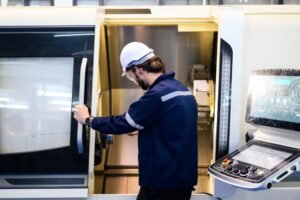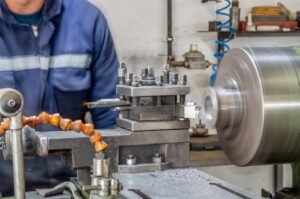When it comes to machining precision parts, two technologies dominate the conversation: Swiss turning and traditional lathe processes. Both shape raw metal into usable components, but they do it in very different ways.
Imagine Swiss lathes as precision instruments akin to surgical tools, built for micro-scale stability, whereas conventional lathes function more like robust workshop hammers—adaptable and muscular for substantial tasks.
This article breaks down the mechanics, efficiency, precision, and costs of each technology. Along the way, we’ll highlight real-world use cases and lessons from industry to help you decide which machine best fits your needs.
Core Mechanisms Compared
Guide Bushing vs Fixed Spindle
Swiss lathes use a guide bushing that supports the bar stock right at the cutting point. This dramatically reduces deflection, making them ideal for long, slender components like medical screws or electronic pins. Without this support, a 50 mm-long part with a 2 mm diameter would flex like a fishing rod under cutting pressure.
Traditional lathes, by contrast, hold the workpiece in a chuck at one end. This setup is fine for short, rigid parts, but long or thin pieces wobble unless secondary supports (like steady rests) are added—slowing down production.
Sliding Headstock vs Fixed Headstock
In Swiss machines, the headstock slides, feeding material through the guide bushing. This motion keeps cutting forces consistent, reducing vibration. Imagine sharpening a pencil by moving the pencil through a fixed blade instead of moving the blade around the pencil—that’s how Swiss lathes achieve stability.
Conventional lathes keep the headstock fixed, rotating the workpiece while tools move across it. This design is simpler and versatile, but it lacks the same stability when handling delicate parts.
Programming Offset Differences
The methodology for applying tool offsets differs significantly between Swiss-type and conventional lathe systems. On Swiss machines, tool offsets move in the opposite direction compared to traditional setups. Operators often describe the switch as “driving on the other side of the road”—it’s the same activity, but your instincts need retraining.
Efficiency and Axis Capabilities
Multi-Axis vs Fewer Axes
Swiss lathes often have 7 to 13 axes, which allows simultaneous milling, drilling, and turning. Multiple operations happen in one cycle, making them unmatched for complexity.
Standard CNC lathes typically function with between two and four axes of motion. They’re excellent for straightforward profiles but require additional setups or machines for secondary features, adding time and labor.
One-Cycle Operations vs Multi-Machine Steps
Case study: A medical device manufacturer producing bone screws cut its production flow from three separate machines to one Swiss turning cycle. This reduced handling errors, improved consistency, and cut cycle time by nearly 40% (Source: Modern Machine Shop, 2021).
Cycle Time and Productivity
Swiss lathes excel in mass-producing miniature components, where their single-setup capability drives peak throughput. Traditional lathes, however, are often faster for large, simple components where multi-axis capability isn’t needed.
Precision and Part Capability
Accuracy from Guide Bushing Support
Swiss machines routinely hold tolerances of ±0.0002 in (5 microns). That’s roughly 20 times thinner than a human hair—a critical difference in industries like aerospace and medical devices.
Long and Thin Parts vs Short and Rigid Parts
A rule of thumb: if the part’s length is more than 10 times its diameter, a Swiss lathe is the safer choice. Even when equipped with vibration dampers or stabilizing rests, conventional lathes often face workpiece chatter issues during fine operations.
Typical Tolerance Ranges
- Swiss turning: ±0.0002 in
- Traditional CNC turning: ±0.001 in
Both ranges are impressive, but the difference can be the line between a functional surgical implant and a rejected one.
Cooling, Tooling, and Setup Factors
Oil Cooling vs Water Cooling
Swiss lathes typically use oil-based coolant, which improves surface finish and tool longevity. The trade-off is higher coolant cost and additional fire safety measures.
Traditional lathes use water-soluble coolants, which are more economical and easier to maintain but don’t deliver the same fine finishes at tight tolerances.
Offset Polarity and Setup Pitfalls
The learning curve is real. New operators often misapply tool offsets when moving from conventional to Swiss systems. This slows setup times and can even lead to costly crashes. Many shops invest in simulation software or specialized operator training to shorten this transition.
Cost, Training, and Investment Considerations
Machine Cost vs Per-Part Efficiency
- Swiss lathes: Higher upfront cost, often double that of traditional CNCs. However, they reduce labor and secondary operations, making them cost-effective at scale.
- Traditional lathes: Lower initial investment, but multi-step workflows increase per-part costs when volumes rise.
Setup Complexity and Operator Training
Swiss machines demand specialized programming skills and careful setup, which means longer onboarding for new staff. Traditional lathes are easier to train operators on, which can be a big factor for job shops with high staff turnover.
Choosing Technology by Batch Size and Precision Needs
A simple decision guide:
- Swiss turning: Best for high-volume, high-precision, small-diameter parts.
- Traditional turning: Best for medium-volume, large-diameter, or less precision-intensive parts.
Applications and Industry Use Cases
Electronics and Medical Parts (Swiss Turning)
Swiss lathes dominate industries where precision is non-negotiable:
- Orthopedic screws and implants
- Dental components
- Watch gears and connectors
- Aerospace sensor components
Automotive and Heavy Parts (Traditional Turning)
Traditional lathes remain indispensable for:
- Shafts, hubs, and brake rotors
- Pipe fittings and flanges
- Large-diameter parts for energy and oil & gas
Industry Comparison Table
| Industry | Swiss Turning Example | Traditional Turning Example |
| Medical | Bone screws, dental implants | Surgical tool handles |
| Electronics | Connectors, watch parts | Housings, heat sinks |
| Automotive | Precision valves | Shafts, brake rotors |
| Aerospace | Mini fasteners, sensor parts | Landing gear components |




